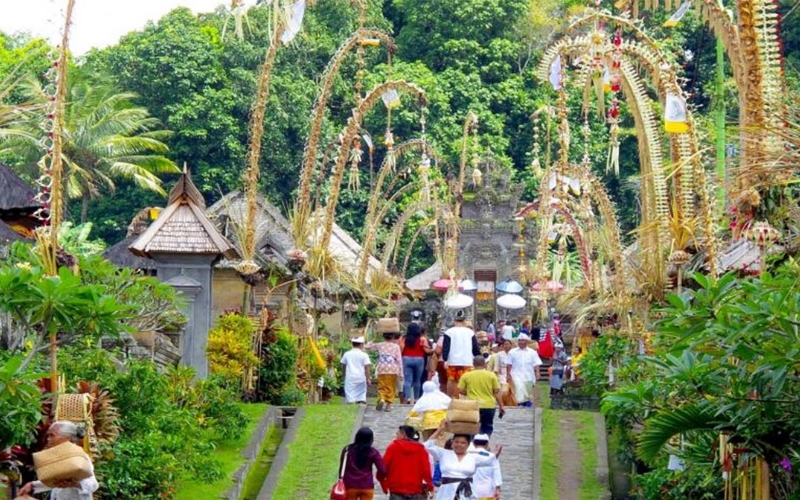Both Galungan and Kuningan are Balinese holidays which celebrates the victory of dharma over adharma (the triumph of good over evil). It marks the time when ancestral spirits relatives visit the Earth. The last day of the celebration is kuningan, when they leave the earth, meanwhile the start of the celebration is Galungan, which marks the time when ancestral spirits visits the Earth. The date of yhis holiday is calculated according to the 210-day Balinese calendar. The holiday is related to Diwali, celebrated by Hindus in other parts of the world, which also celebrates the victory over dharma over adharma. Diwali, however is held at the end of the year.
Galungan marks the beginning of the most important recurring religious ceremonies. The spirits of deceased relatives who have died and been cremated return to visit their former homes, and the current inhabitants have a respinsibility to be hospitable through prayers and offerings. Preparations already starts at Tumpek Uduh, 25 day before Galungan starts, at saturday of the 7th week of the Balinese Pawukon calendar, Wariga. The total length of the ceremony period therefore extends to 34 days
One of the main characteristics of the ceremonies period is the inner struggle between dharma and adharma, which is symbolized by the Kala-tiganing Galungan or Sang Kala Tiga who descends three times to Earth to tempt mankind to adharma (evil). The most obvious sign of the celebrations are the penjor – bamboo poles with offerings suspended at the end. These are installed by the side of roads. The while island sprouts with these tall bamboo poles, which are usually decorated with fruit, coconut leaves, and flowers and set up on the right of every residence entrance. At each gate, there’ll also be small bamboo altars set up especially for the holiday, each one bearing woven palm-leaf offerings for the spirits.
Three days before Galungan, families begin their preparations with Penyekeban means “the day to cover up”, as this is the day when green bananas are covered up in huge clay pots. The following day after Penyekeban is Penyajahan, which is the time of introspection for balinese and, more prosaically, a time to make the Balinese cakes known as jaja. These colored cakes made of fried rice dough are usually used in offering, and are also eaten especially on Galungan.
After Penyajahan is Penampahan, or morely known as slaughter day. On this day, Balinese people slaughter the sacrificial animals that will go into the temple or altar offerings. Galungan is marked by a sudden surplus of traditional Balinese food, like lawar and satay. the following day would be marked as Galungan day. On this day. Balinese devotees pray at temples and make their offerings on their heads, while men bring palm fronds. In Umanis Galungan, people will hold prayers and continue with Dharma Santi and visit each other relatives or recreation areas.
Children would do the ngelawang tradition today. Ngelawang is a tradition. In which children will dance barong accompanied by gamelan from the door of one resident’s house to another (lawang to lawang), residents will then come out of the house carrying canang and sesari money, Residents believes that with this barong dance, it can expel any negative auras and bring positive auras. Umanis Galungan fallas on wuku Dungulan on the Balinese calendar. Tommorow, markrs the end of the Galungan holiday, and the start of kuningan day.
Kuningan is celebrated every 210 days. ten days after Galungan. The Balinese believes that Kuningan is the day when their ancestors return to heaven after visiting the Earth during Galungan. They make offerings to be given to the ancestors on their farewell day. offerings may include yellowed rice (the word ‘Kuningan’ is derived from teh word ‘Kuning’ which means yellow) which is placed in a small bowl made of coconut leaves. Other common offerings would be seeds, fish, fruits like papaya and cucumber. The yellow rice would be symbol of human’s gratitude towards God for all the life, joy, welath, health and properity given. The bowls are decorated with a small figures of shadow puppets which represents angels that brings joy and wealth to Earth. It’s also said that on Kuningan, Ida Sang Hyang Widhi (teh God of Balinese Hindu) is blessing and giving prosperity to the whole world. Many believes that the celebration should be done before noon, before the gods and goddess return to the heavens to continue their asceticism.
While on Kuningan day, you’ll be able to see tamiang and endongan decorations hanging outside homes and temples. Tamiang is an object that is formed as a round shield and repesents protection, defense and the cycle of the globe. it functions as a reminder to humans of karma, and that they should protect themselves from bad behavior. Meanwhile, Endongan means bag of provisions. It is made of coconut leaves and shaped like a bag or a pocket. Balinese put different things like seeds, fruits or tubers inside the endongan. Some people sees it as a symbol of food supply for the journey of the ancestors from Earth to heaven. From a spiritual view, endongan represents the essential provisions that every human should carry-knowledge and homage

